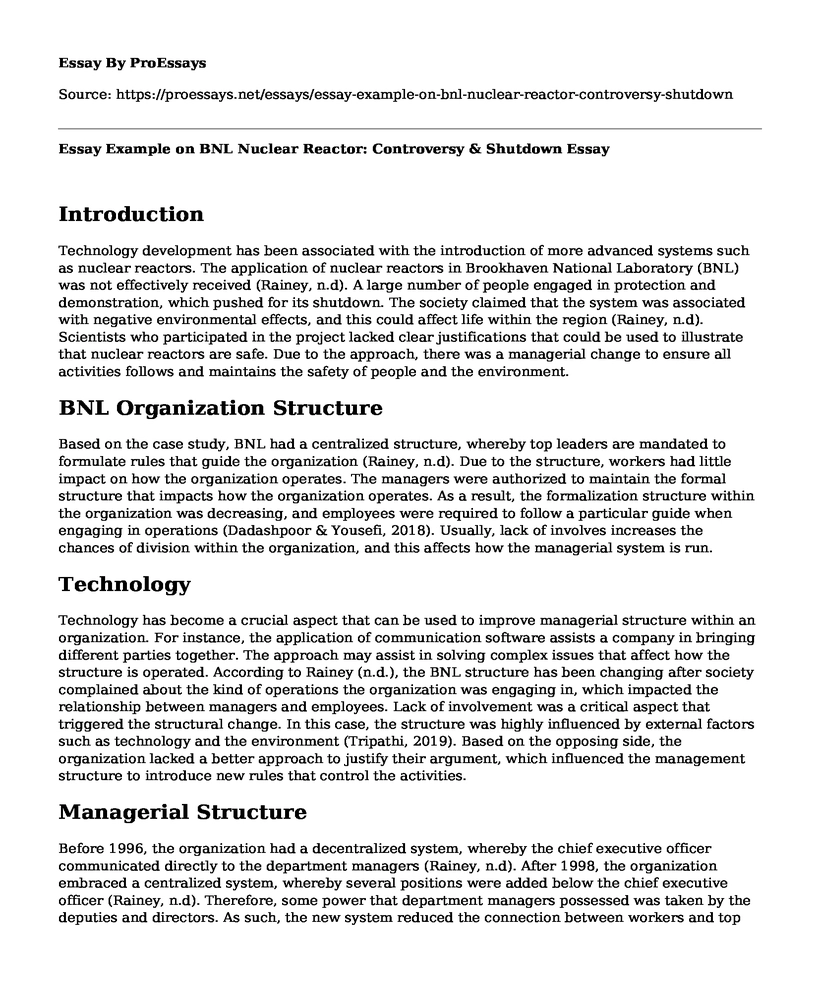Introduction
Technology development has been associated with the introduction of more advanced systems such as nuclear reactors. The application of nuclear reactors in Brookhaven National Laboratory (BNL) was not effectively received (Rainey, n.d). A large number of people engaged in protection and demonstration, which pushed for its shutdown. The society claimed that the system was associated with negative environmental effects, and this could affect life within the region (Rainey, n.d). Scientists who participated in the project lacked clear justifications that could be used to illustrate that nuclear reactors are safe. Due to the approach, there was a managerial change to ensure all activities follows and maintains the safety of people and the environment.
BNL Organization Structure
Based on the case study, BNL had a centralized structure, whereby top leaders are mandated to formulate rules that guide the organization (Rainey, n.d). Due to the structure, workers had little impact on how the organization operates. The managers were authorized to maintain the formal structure that impacts how the organization operates. As a result, the formalization structure within the organization was decreasing, and employees were required to follow a particular guide when engaging in operations (Dadashpoor & Yousefi, 2018). Usually, lack of involves increases the chances of division within the organization, and this affects how the managerial system is run.
Technology
Technology has become a crucial aspect that can be used to improve managerial structure within an organization. For instance, the application of communication software assists a company in bringing different parties together. The approach may assist in solving complex issues that affect how the structure is operated. According to Rainey (n.d.), the BNL structure has been changing after society complained about the kind of operations the organization was engaging in, which impacted the relationship between managers and employees. Lack of involvement was a critical aspect that triggered the structural change. In this case, the structure was highly influenced by external factors such as technology and the environment (Tripathi, 2019). Based on the opposing side, the organization lacked a better approach to justify their argument, which influenced the management structure to introduce new rules that control the activities.
Managerial Structure
Before 1996, the organization had a decentralized system, whereby the chief executive officer communicated directly to the department managers (Rainey, n.d). After 1998, the organization embraced a centralized system, whereby several positions were added below the chief executive officer (Rainey, n.d). Therefore, some power that department managers possessed was taken by the deputies and directors. As such, the new system reduced the connection between workers and top managerial systems since the information had to go to numerous stages before they reach the chief executive officer. Additionally, the centralized system impacted the organization to concentrate power on a particular point, which reduced other heads from participating in activities related to the managerial system (Dumitru et al., 2016).
Conclusion
Conclusion. The success of an organization highly relies on its managerial structure. The change in structure in BNL has highly affected how employees participate in operations. In most cases, a centralized system tends to be influenced by particular aspects to formulate policies. The aspect highly affects the relationship between parties. Technology is a crucial aspect that enhances the connectivity within an organization. As a way of enhancing the effectiveness of the structure, BNL should introduce technology systems such as software, which enhances communication among parties.
References
Dadashpoor, H., & Yousefi, Z. (2018). Centralization or decentralization? A review on the effects of information and communication technology on urban spatial structure. Cities, 78, 194-205. https://www.udparty.com/php/upload/20180328/15222481058c1f52eaa837474e.pdf
Dumitru, A., Budica, A., & Motoi, A. (2016). Managerial-systemic profile of a tourism company. Polish Journal of Management Studies, 13(2), 36-45. https://yadda.icm.edu.pl/baztech/element/bwmeta1.element.baztech-37184c34-4ff1-4ddd-b4e1-54ac81b0a896/c/Dumitru_PJMS_13_2_36.pdf.
Rainey, H, G. (n.d.). Brookhaven National Laboratory. (pp. 1-5).
Tripathi, S. (2019). Determinants of cloud computing intentions to use: Role of firm's size, managerial structure and industrial sector. Journal of International Technology and Information Management, 28(2), 51-92. https://scholarworks.lib.csusb.edu/cgi/viewcontent.cgi?article=1405&context=jitim.
Cite this page
Essay Example on BNL Nuclear Reactor: Controversy & Shutdown. (2023, May 03). Retrieved from https://proessays.net/essays/essay-example-on-bnl-nuclear-reactor-controversy-shutdown
If you are the original author of this essay and no longer wish to have it published on the ProEssays website, please click below to request its removal:
- How Have Cell Phones Changed Communication?
- Essay Sample on Nanotechnology
- Essay Example on US-China Trade War: Top Leaders' Phone Call to Resume Negotiations
- Essay on Humans Evolve to Improve Quality of Life Through Innovation
- Essay Sample on Deep Learning: A Crucial Component of Artificial Intelligence
- Paper Sample on Cybersecurity in the UAE: Analyzing Threats, Techniques, Solutions
- Free Essay Example on Product Innovation: Re-Inventing the Life Cycle







